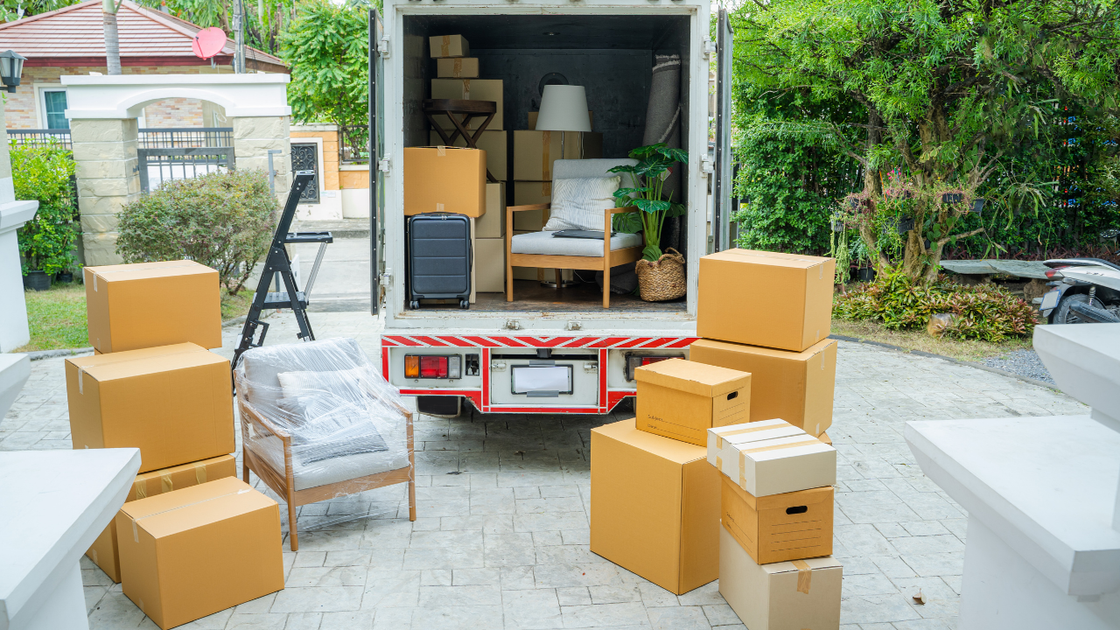Imagine going through the whole pre-approval process... getting your offer accepted on a house... going through inspections and appraisals...
You think the hard part is over. Closing day is approaching, and you realize… “I need to start packing” 😳. A whirlwind of questions twirl in your mind:
- What do I pack first? And what order do I pack in?
- Do I hire professional movers or DIY-it?
- What’s the safest way to pack all the valuables and fragiles?
If you’ve never done a full house move before, the thought of it can be intimidating, overwhelming and costly. And you’re not alone. Each year approximately 10-15% of the US population relocates. This equates to a substantial figure of around 32 million individuals who move in any given year.
Whether moving for a new job, or a change in lifestyle, or the pursuit of fresh beginnings, we all are looking for ways to make our moves easier. So let’s dig into the 8 foolproof ways you can make your journey easier:
📮 RELATED POST: PREPARING TO BUY A HOUSE: 5 TIPS TO SAVE YOU MONEY
1. Create A Moving Checklist
Laying the groundwork for a stress-free move begins with crafting an exhaustive moving checklist. This pivotal step diminishes anxiety and means you have everything logged in one place, so no panicking when you’re not sure what you should be doing next!.
To aid you in constructing a comprehensive and efficient checklist, you’ll want to organize it as a timeline. For example, 8-10 weeks before the move you’ll want to coordinate the move date with all the essential parties, and decide on a budget, and if you have a landlord you’ll need to notify them to give notice of your departure.
At 4-6 weeks out you’ll likely begin packing the non-essentials that you might want to put into storage. Use this handy timeline template to make your move real easy!
2. Decision Time... Do You Hire The Pros?
In the midst of the moving puzzle, a pivotal choice surfaces: Should you tackle the move independently or engage professional movers?
Even the simplest of house moves (i.e. moving one mile down the road) can still rack into the thousands when hiring a professional moving company. This leaves many buyers hesitant to make such a huge expense when their bank accounts will be taking a HUGE hit in buying a house.
If you’re debating whether to hiring movers, let’s talk about the pros and cons:
👍📦 PROS: DIY MOVING
- Economical — naturally you’ll save money when not spending potentially thousands of dollars on movers
- Personal control — you don’t need to worry about items being broken, or things being lost in the move, as you have full control over everything
- Flexibility — movers need weeks (or months) of notice, and sometimes our home moves are a bit more urgent than that. Or maybe you’re not 100% sure on timings, so you’d rather keep your options open rather than tying yourself to a certain date.
👎📦 CONS: DIY MOVING
- Time-consuming — you save money, but how much is your time worth? When planning for a move there’s many things that need doing, so sometimes you’d rather pay for the convenience of other people doing it, rather than spending hours and days wasting your own time.
- Physically demanding — doing it yourself isn’t for everyone; moving often involves some strenuous lifting. Unless you have a big helpful family, or friends who’ll happily give up their day to help you in exchange for pizza and beer, hiring professionals makes sense.
- Limited expertise — professionals charge a lot for a reason. They know how to move your items quickly and safely. They know how to move that huge corner sofa around a tight corner.
👍🚛 PROS: HIRING MOVERS
- Expertise and efficiency — if you’re looking to get your move done quickly and seamlessly, it’s a no-brainer to hire people who know exactly what they’re doing, and in the fastest possible manner.
- Time-saving — many people cannot take days off work to handle their move, or they might have children that need looking after, so if you’re needing to get back to the office or taking care of the kids, hiring movers is a no-brainer. You might even be lucky and be able to have a parent or friend on hand to deal with the movers so your time is freed up.
- Stress reduction — there’s a reason why most people joke about needing a bottle of wine at the end of moving day! It’s hard, stressful, and strenuous. Hiring pros takes the mental and physical load off so you can enjoy your move.
👎🚛 CONS: HIRING MOVERS
- Higher cost — naturally, hiring professionals comes with a cost, and not everyone can afford it. Ask your family and friends for recommendations and start ringing around for quotes ASAP so you can work it into your budget.
- Less control — Type-A personalities might not be comfortable relinquishing so much control over such a huge and important event.
- Potential scheduling mismatches — so you’ve gotten recommendations from family, looked up reviews and selected your ideal mover… only to find out they aren’t free on the day you need to move. You need to decide if you’re willing to find an alternative available mover, or move your entire schedule around to accommodate your chosen movers. What do you do?
Ultimately, the choice hinges on your priorities. While opting for a DIY approach might save money, professional movers bring unparalleled convenience and expertise, significantly simplifying the moving process.
3. Embracing Minimalism
Moving marks a fresh start. Why not take this chance to embrace minimalism and start decluttering? Liberating yourself from possessions that no longer serve you is pivotal, and lightening your load makes way for exciting new horizons. Consider these effective decluttering strategies:
- Expiry Date Rule: Applying a metaphorical ‘expiration date’ to your items can help you make decisions.
- Donate or Sell: Make smart decisions about the items you no longer need: can you sell them and make some money, or are they for the donate pile?
Decluttering paves the way for a seamless move and ignites anticipation for the adventure ahead.
4. Pack An Essentials Box
So you arrive at your new home, the movers have finished and you’re surrounded by a sea of boxes... you need to use the toilet, you want to change out of your sweaty shirt, and you’re starving and can’t wait for a pizza delivery.
The thought of having to go through all your boxes to find the items you need sounds stressful, and you wish you’d planned ahead. So, simplify your move by assembling a “Survival Kit” containing essentials like:
- A change of clothes
- Phone chargers
- Toilet paper
- Paper towels
- Cleaning supplies like sponges, dish soap, hand soap
- Snacks like protein bars, plus water and gatorade
- Bath towels and hand towels
- Clean bedding and pillows
This preparedness box ensures a smooth transition into your new space, saving you from rummaging through countless boxes on day one. Remember to label this box distinctly for easy identification amidst the sea of moving containers.
5. Inventory And Getting Smart With QR Codes
Elevate your packing game by leveraging the digital realm. There’s many paid apps and tools that do this for you, but if you want to maintain full control of your logistics, you can easily create your own inventory checklist for free. Here's a comprehensive approach:
- Inventory list: Create an inventory on Google Sheets or Excel, meticulously listing every box you pack, with the contents of each box.
- Clear box labeling: To be able to match the box to your inventory list, assign a name or number to the box on your spreadsheet, and write that on the box with a Sharpie or sticky label.
- Get smart with QR codes: Elevate your strategy by generating QR codes using a tool like Canva or bit.ly. You can print out the QR code on a label for each box which, when scanned, will bring you to the correlating tab of your spreadsheet to show the contents!
This tech-savvy approach simplifies unpacking; if you need a certain item then at any time you can consult your spreadsheet, use the Find function, and locate immediately which box it’s in. This ensures a seamless transition as you move to your new home.
6. Easy Furniture Rebuilding
Disassembling and reassembling furniture can be a huge pain in the you-know-what when moving… particular if you’re not hiring professionals to help you. Lost screws and damaged parts can cause such stress, especially when trying to rebuild your bed which you desperately want to sleep in after a long day’s move! Let’s go over the steps you can take to minimize those stresses:
- Film disassembly: For every piece of furniture you tear down, document the disassembly process on your phone’s camera to make things easier the other end. Not sure which part goes where? You’ve got it logged.
- Manuals in wallets: Many of us don’t keep manuals for years-old furniture, but if you have them, be sure to tore them in labeled plastic wallets, which can then be stowed in a box and documented using your handy inventory list!
- Bag hardware: Losing screws, knobs and anything else important can be incredibly frustrating, so buy some small sandwich bags (or reusable Stasher bags!) for all parts per each piece of furniture, label each bags, and stow in the same box as the manuals.
- Attach hardware to manuals: Even better, if you have the manual, duct-tape your hardware bag to the corresponding manual, or keep in the plastic wallet you stash the manual in.
- Protect fragile parts: Safeguard delicate components with appropriate wrapping.
Adhering to these guidelines ensures an organized furniture disassembly and reassembly during your move.
7. The Russian Doll Technique
Did you know? Matryoshka dolls, known most commonly as Russian nesting dolls, comprise sets of dolls of decreasing sizes that fit inside each other. They’re used as toys and decoration across the globe!
THE MATRYOSHKA PRINCIPLE
Russian nesting dolls introduce the "Matryoshka Principle." This concept involves nesting objects within other, larger objects – a pattern observed in nature and craftsmanship alike.
It's a sequence where each element encapsulates the previous one and encloses the subsequent one. You can use this technique when moving to maximize your packing space and keep your delicate items protected. Do this by:
- Prioritizing smaller items for nesting: First identify your smallest and most fragile/losable items that can be stashed inside bigger items. Think things like knick knacks from your 'everything draw', gadgets and TV remotes, shelf decor, jewelry.
- Opt for sturdy containers: Those smaller items can now be packed inside bigger items, like laundry baskets/hampers, trash cans, tupperware, saucepans etc. Just be sure to label where every item is in your spreadsheet!
- Cushion delicate items adequately using things you already have around the house, like clothing, blankets, throws, cushions
Some other examples to keep you organized include slotting hats inside each other (i.e. roll up beanie hats to nestle inside baseball caps), roll thin clothes inside larger clothing, fold up pajamas and underwear inside pillow cases, stuffing your socks inside shoes, stowing coin purses and wallets inside backpacks and larger purses, and stashing silverware and small kitchen items inside tupperware or baking trays that have lids (between layers of paper towels to prevent rattling and scratching)... you get the idea!
8. Consider Using A Moving Pod
Amidst your moving adventure, a storage dilemma surfaces: should I pay for storage to make my move easier? Which then leads to the debate of: storage units vs moving pods? To make an informed choice, assess your needs and consider convenience.
👍🏪 PROS: STORAGE UNITS
- Security — well-reviewed storage units usually offer incredible security to protect your most-precious furniture and items. Bring your own secure padlock for extra protection, and make sure there’s plenty of CCTV at the site you choose.
- Climate control — if you’re worried about your items sitting in the perishing summer heat, or freezing and thawing on chilly winter nights, a storage unit with climate control will protect your valuables.
- Varied sizes — storage units can actually be very affordable if you only need a small space. Alternatively if you’re wanting to store everything you own, most units can accommodate, giving you tons of flexibility.
👎🏪 CONS: STORAGE UNITS
- Travel required — it can be stressful and time-consuming schlepping items to and from your unit, and you may not have the vehicle to move the big stuff.
- Limited access — you might not have a unit near your house, so traveling 30 minutes away to seek out a must-needed item that you didn’t mean to pack and require RIGHT NOW might not be feasible.
- Fees — inevitably there are daily or monthly fees for storing all your items on-site, and this may not be in your budget.
👍🫛 PROS: STORAGE PODS
- Convenience — you packed a box and realize you need to grab something? Super easy — the pod is in your driveway!
- Flexibility — organizing home storage pods is usually pretty easy, and you can get it delivered on the day you need.
- Doorstep delivery — to avoid running back and forth to a storage unit multiple times a day or week, pods offer the convenience of being dropped off right to you, and you might not even need to be home to intercept!
👎🫛 CONS: STORAGE PODS
- Reduced security — unless your home comes equipped with CCTV and chain-link fences, your pod is exposed on your driveway. Attach a secure padlock to keep your belongings protected.
- Time limits — since you’ll be vacating your house to move onto another one, pods are usually less flexible on timings than storage units, where you can usually leave your items for months or years on end! Having a pod means it has to be moved from one place to another, so you need to be more organized.
- Exposure to weather — while pods tend to be fairly secure and leak-proof, they usually aren’t anywhere near as enclosed as on-site storage units.
Do you have more questions about moving in South Jersey? Message The JFKLiving Team, and we're more than thrilled to guide you through your real estate adventures 🦄🤘







